Showing 81-100 of 159 results
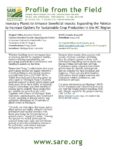
Native Plants Attract Beneficial Insects
Whether building boxes for mason bees or planting habitat for predatory beetles, farmers seeking sustainability can encourage populations of pollinators and beneficial insects on the farm. Researcher Doug Landis knows that many native plant species are highly attractive to both pollinators and natural enemies, and with help from a $199,887 NCR-SARE Research and Education grant, […]

Sprinkler Deterrent System Helps Farmer Control Wildlife
Enhancing biodiversity on a farm can result in cleaner air and water and increased wildlife. But what happens when the wildlife gets a little too close to your crop? That’s the problem sweet corn grower, Scott Kelly, was facing on his farm near Kearney, Missouri. “The demands of growing produce sometimes seems never-ending,” said Kelly. […]

An Open-Source, Automated Irrigation System for Small Farms
Christian and Katie Flickinger were experienced urban farmers in Michigan who were farming eight plots in various locations. When they decided to consolidate their operation and buy a 7-acre farm in Howell, Michigan, they faced the challenge of converting a long-standing, non-rotated cornfield into the organic, heirloom farm of their dreams. Among the other items […]

Soil Remediation Techniques in Urban Agriculture
Dirty Boots Farm in Illinois received SARE support to work with a neighboring farm, Chicago Patchwork Farms, on urban soil remediation.

Controlling Pigweed with Minimal Tillage in Fall Vegetable Crops
Managing and controlling weeds is an ongoing challenge and frustration for many farmers, but it can be especially cumbersome for organic producers, whose options for herbicides are limited. For these organic producers, no-till and conservation tillage systems can help conserve soil and can be used for weed control. Tom Buller, a vegetable grower and extension […]
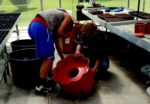
Farm Towers: Urban Agriculture Goes Vertical
In southeast Nebraska where corn and livestock fields dominate the agricultural landscape, Auburn High School agriculture teacher, Ashton Bohling, offers a variety of agricultural education opportunities for curious youth. Students have access to an aquaponics system (an aquaculture system with tilapia) and a 24x48’ greenhouse. With support from a $1,999 NCR-SARE Youth Educator grant, Bohling […]
Spring-Grazing Cover Crops with Nebraska’s Knuth Farms
When a fourth-generation farm in Mead, Nebraska began to diversify their primarily cash crop operation in 2012, they gave some thought to cover crops and livestock. Knuth Farms didn’t want to buy cattle or become beef producers, but they did want to diversify their income stream, capture some of the soil benefits of cover crops, […]
Developing a Woman and Farmer-Led Meat Processing Cooperative
Wisconsin needs more butchers. That’s what April Prusia, Betty Anderson, and Bethany Emond Storms determined during their farmer-led research project in 2017. The three livestock producers raise beef, pork, poultry, and goats in south central Wisconsin. While they all have big dreams of charcuterie plates made with their meat, they lack processing options in the […]
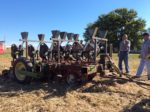
Illinois Farmer Builds Precision Seeder to Maximize Cover Crop Advantage
Ralph “Junior” Upton is no novice when it comes to no-till and cover crops. His grain farm in the northeast corner of Hamilton county Illinois is 100% no-till with 1,800 acres of corn, beans, and wheat, and approximately 1,200 acres in cover crops. Upton has been farming more than 50 years, and the farm has […]
Traditional Fertilizer, Modern Applications for Iroquois White Corn
Farmers have long relied on liquid fish fertilizers because they are a source burn-free nitrogen, phosphorus, and potassium. Traditional Native American growers were well aware of the benefits that decaying fish could bring to their soil; they buried fish under mounded soil and planted the 3 Sisters (corn, beans, and squash) directly on top of […]
Immigrant and Minority Farmers Inspire Soil Health Collaboration
When Julie Grossman was an undergraduate, she had no idea that a single economic development course was going to change the trajectory of her life’s work. In that course, and during her international PhD research in Latin America, she learned how biology, and specifically agroecology, could be used to help grow food in regions of […]
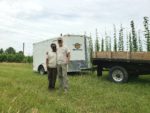
Ohio Farmer Develops Mobile Hops Dryer
In a state that boasts 300 craft breweries, David Volkman is among many craft beer enthusiasts in Ohio. But Volkman, with 12 acres of land in Warren County, is not only supporting Ohio’s craft brewing industry through consumption; he’s also contributing to its production. In 2012, he and his wife, Nina, started transitioning some of […]
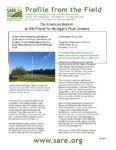
The American Kestrel: an IPM Friend for Michigan’s Fruit Growers
Cherry producers across the region are all too familiar with starlings, finches, voles, pocket gophers, and other animals that can wreak havoc on a cherry orchard by feeding on ripening fruit and developing roots or shoots. These little pests can be a big problem for Michigan’s cherry growers, who grow 75 percent of all tart cherries and 20 percent of sweet cherries in […]
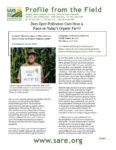
Does Open-Pollinated Corn Have a Place on Today’s Organic Farm?
On 205 acres near the picturesque bluffs of the Mississippi River, Stanley Smith raises beef cows and grows organic corn in southeastern Minnesota. He grew up on this small farm in the rolling hills of Winona County and worked in partnership with his dad until his dad retired. Smith and his wife, Vickie, purchased the […]

Iowa Farmers Seek Sustainability with Cover Crops and No-Till
In 2002, a $6,500 SARE grant funded an idea for a new tool at the Rodale Institute in Kutztown, Pennsylvania. The tool was a roller-crimper, a steel drum with blades that was mounted to a tractor and used to roll down cover crops. The idea was that the mat of dead cover crops would act as mulch, which researchers hoped no-till farmers […]
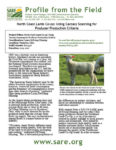
North Coast Lamb Co-op: Using Carcass Scanning for Producer Production Criteria
In 1865, the National Wool Growers Association was formed. This first-ever national livestock association in the U.S. laid the groundwork for the organization we know today as the American Sheep Industry Association (American Sheep Industry Association, 2018). “The American Sheep Industry may be the oldest livestock organization in the county, however, American lamb consumption and […]
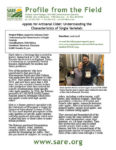
Apples for Artisanal Cider: Understanding the Characteristics of Single Varietals
Hard cider is a beverage that is rooted in history, dating back to 55 BC when the Romans discovered it in England. Today, it is emerging as a potentially fruitful business opportunity for modern and future producers. Two of the producers who have contributed to that growth are Wisconsinites Marie and Matt Raboin, who made their […]
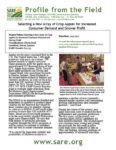
Selecting a New Array of Crisp Apples for Increased Consumer Demand and Grower Profit
Apples are the most consumed fruit in the U.S. The United States has 7,500 apple producers who grow, on average, 240 million bushels of apples each year. These producers grow the apples on an approximated 322 thousand acres of land (U.S. Apple Association, 2018). Two of those apple producers are Steven and Connie Doud, who own […]
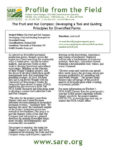
The Fruit and Nut Compass: Developing a Tool and Guiding Principles for Diversified Farms
As interest in diversified perennial production grows, farmers across the region have been searching for sustainable ways to battle pests, tap into lucrative markets, and increase yields as they work to develop biodiverse agricultural ecosystems. Building on the concept of their Veggie Compass project, and the desire to develop whole farm profit management tools and […]
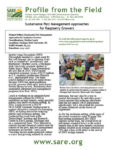
Sustainable Pest Management Approaches for Raspberry Growers
Spotted wing Drosophila (SWD) (Drosophila suzukii) is a gnat-sized fly that will damage ripe or ripening fruits such as raspberries, strawberries, and blueberries. Heather Leach, a Michigan State University graduate student in Rufus Isaacs’ Berry Crops Entomology lab says that in 2014, SWD caused estimated economic losses of $159 million in U.S. raspberry production (Burrack […]